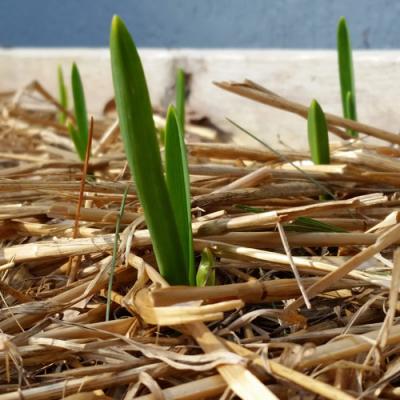Just a Thought: March 1, 2017
The spice of life
Some call it vampire repellent. Some call it the Stinking Rose, or Russian Penicillin. But if you tend to vascillate between seasonally-affected depression and claw-your-eyes-out cabin fever come early March (like yours truly), you might want to call garlic preventive medicine.
Garlic's health benefits are widely recognized, whether cooked or capsulated. But I've not yet come across anyone touting its very growth as a panacea. Maybe it's time to change that.
Garlic growers – or planters of any bulbs, really – know the magic of those little life-containing papery bundles that bravely withstand the coldest of winters and heaviest snowfalls, only to sprout delightfully come spring (or, in some cases, February).
But garlic is exceptional. Where we live, I sow it around Veterans Day. Sometimes in snow boots, sometimes in shorts. This year, I planted just after the tumultuous election cycle that challenged all of us, regardless of which candidate we supported.
But when you feel ungrounded, get closer to the ground. And plant something in it, if you can.
In fall, you prepare the soil, with composted kitchen scraps and shed leaves you've raked up. Garlic is a "heavy feeder," and needs a lot of nutrition to produce the buxom cloves that cooks lust after.
Accordingly, garlic planting also involves a little Darwinian culling: You save the biggest bulbs from the last year's crop – regardless of how badly you want them in your soup – so that your future bulbs will have the best genes.
You head out on a short November day and plunk a bunch of broken-apart bulbs into the soil, clove by clove. Then, you lightly cover the tops of the cloves with soil, mulch the bed with straw or leaves, and wait.
And wait. And wait.
Temperatures drop, winds blow, frost heaves the ground, snow blankets everything. Holidays come and go, playoffs come and go, New Year's resolutions come and go. Inaugurations, Oscar nominations, winter vacations … and through it all, those little cloves hang out, waiting along with you for the lengthening reach of the sun to beckon them into the light.
Once they get the cue, they're off and running. They slough off winter's heavy hibernation like college students donning flip-flops the second the snow melts.
In our backyard, they're now about four inches tall. Ahead of schedule, but hardy enough to survive whatever's left of this season. Come late May or June, they'll sprout flowery scapes that make a killer pesto. By late July, it'll be time to dig the bulbs for drying and curing, first setting aside those standouts that'll carry on the lineage next fall.
So you put a tiny little thing in the ground, and it knows what to do. It trusts in the earth and in life to go on, even when you're questioning such things, yourself. It harbors no existential angst. It just feeds you, in every sense of the word.
Admittedly, I'm not always much of an optimist by nature. But it's in nature that I find that little voice that says, be patient. See the good. And know's that there's always good to see.
Katie Chriest can be contacted at katie@ErieReader.com.


.png)
